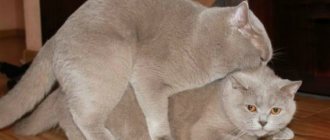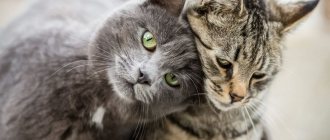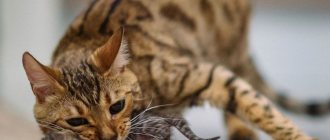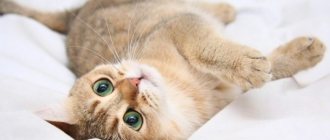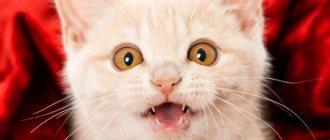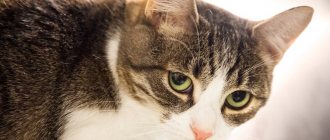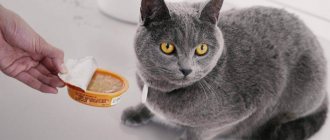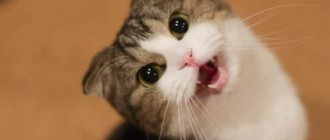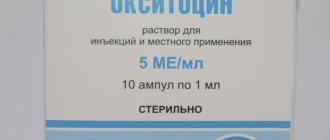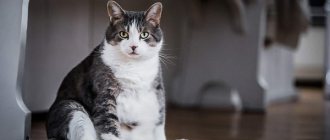Cats are surprisingly “active” and productive animals. It is known that one animal can have about 200 kittens in its entire life; cases have also been described when a cat gave birth to more. What is the reason for this fertility? Largely due to the fact that childbirth in a cat does not mean inhibition of reproductive function. If there is a cat nearby, the female may begin sexual heat almost the next day after the kittens are born!
General information
So, as we have already indicated above, cats belong to the category of very prolific animals. More precisely, small cats. This is not surprising, since the species tries to maintain its optimal numbers in this way. If you look at “orphan” animals, then without any surprise you can reveal that out of a dozen kittens born, barely two or three individuals survive to the age of one year . And this is in the relatively comfortable conditions of modern megacities, where homeless cats have no problems with food.
In more severe natural conditions, “debit and credit” may generally converge in a negative proportion. Predators, climate, and other unfavorable factors can lead to the death of not only the entire litter, but also the mother herself. All this leads to the fact that the cat’s body is programmed by nature for maximum productivity. It is for this reason that the cat begins to walk (or rather, can begin) almost immediately after giving birth.
But if in natural conditions such fertility is more than justified, then in domestic conditions it is not so much. Moreover, this leads to numerous problems, which we will write about below.
Sterilization during heat
Veterinarians believe that the best time for sterilization is before the first heat. But it happens that estrus comes as a surprise to the owner, or he did not dare to undergo surgery for a long time. The pet's behavior prompts the owner to castrate the animal when it is in heat. However, veterinarians are against it, as the risks of internal bleeding are high. Sterilization during heat is generally carried out only for medical reasons.
The best time is 2 weeks before or 2 weeks after estrus. Only in the case of incessant heat syndrome is sterilization carried out during estrus.
What are the risks of constant pregnancy?
Exclusively by an increase in the number of stray animals (in the case of stray cats), as well as depletion of the mother’s body (in the case of “industrial” reproduction). In general, constant pregnancy is harmful for cats . After all, you and your pet do not live in the jungle, where kittens and cats can be eaten at any moment, so such high fertility only causes a lot of problems.
Interesting fact: frequent postpartum heats are typical for cats whose litters constantly contain “rejected”, underdeveloped kittens.
Moreover, in such cases, the mother often eats the entire litter and immediately begins to “hunt” for the cats. This is also a physiologically based phenomenon. If an animal feels that the offspring has “failed,” its body tries with all its might to fulfill the reproductive function assigned to it. That is, get rid of an unnecessary brood and urgently get pregnant again.
When cats start walking
The main question that worries cat breeders is at what age does a pet go into heat for the first time?
Several factors influence when a cat matures:
- Breed;
- Finding a male nearby;
- Dimensions of the animal;
- Cat color;
- Season.
On average, a cat begins to go into heat for the first time at 6-8 months . However, the process is quite individual and may not start for longer. The start of estrus before one year is considered the norm.
If your pet does not go into heat before the age of 1 year, this is a deviation and you should immediately seek the help of a veterinarian.
The phenomenon known as “erased estrus” is common. In this case, the process of sexual interest is almost not manifested. Most often occurs in unhealthy cats.
Is it possible to prevent postpartum sexual desire?
In principle, heat immediately after birth is not a very typical case, and we would recommend showing such a cat to a veterinarian. But estrus may well be triggered by irritants from the external environment. The main factor is the presence of a cat nearby. Sometimes even the company of a long-neutered and completely “incompetent” pet is enough. Thus, in cases where you have several pets of different sexes at home, the cat after giving birth must be isolated from them in a separate room.
In addition, try to minimize the effect of stress factors on your pet. Protect her from sharp and loud sounds and smells, and do not start renovations at home at least until the kittens begin to feed on their own. Otherwise, the cat’s body may “wedge” and she will decide that the cubs, being in “mortal danger,” are doomed anyway. And therefore she can leave them and start walking again.
Quality nutrition plays an important role. If the animal’s body receives all the nutrients, micro- and macroelements, then there will be no problems with the kittens’ nutrition . But in the opposite cases, everything is much worse. When a cat’s body “feels” that it is “not up to the task” of feeding kittens, a biological mechanism can come into play, the essence and results of which we have already written about several times above. So it is in your best interests to feed your newborn pet normally.
Number of births per year
Veterinarians and breeders (people involved in breeding new breeds) are confident that a normal animal should not give birth more than 1.5 times every 3 years . This means that on average a cat should not have more than one birth per year.
Otherwise, the pet will quickly become exhausted, and the body will be subject to various pathological processes. Life expectancy decreases, each subsequent offspring will be weak, painful and non-viable. A cat may develop malignant neoplasms in the mammary glands and genitals.
What to do if your pet goes on a spree?
Firstly, be mentally prepared for the need to feed kittens on your own. Practice, unfortunately, proves that such cats almost always lose milk. This is due to a sharp change in hormonal levels. The released compounds block the synthesis of prolactin, that is, the hormone responsible for milk production. Accordingly, the kittens are left without their natural food.
Let us immediately warn you that you should never use cow or goat milk to feed babies, since their characteristics are very different from cat milk and often cause severe digestive disorders. And for small kittens the latter are deadly.
Secondly, under no circumstances use hormonal medications to stop estrus . The body of an animal that has gone into heat immediately after birth is already experiencing powerful overloads. There is no need to aggravate the matter with an influx of “third-party” hormones of synthetic origin. In such cases, the matter may end in oncology.
Consult your veterinarian and choose more gentle sedative drugs on a natural basis. They will allow you and your cat to safely survive the hunting period.
Causes of prolonged estrus in cats
Various factors can provoke disruption of cycles. But the main reasons for the development of prolonged estrus in a cat are:
- hormonal imbalance while taking specific hormonal medications;
- violation of animal care;
- unbalanced diet;
- lack of normal lighting in the house;
- problems in the functioning of the thyroid gland - hypothyroidism, characterized by reduced production of hormonal substances;
- disorders in the reproductive system - underdevelopment of the ovaries or their absence;
- pathologies in the ovarian area - malignant neoplasms or cysts.
Duration and frequency of estrus
If the heat does not end with fertilization, the cat walks without a cat for 7-10 days, after which gradually all signs weaken and the animal calms down until the next time.
Some individuals with hereditary or hormonal characteristics walk for 14 days, which greatly exhausts not only themselves, but also their owners.
A successfully mated female calms down 1-2 days after meeting the cat - she ovulates and fertilization occurs. In this case, she reacts aggressively to the cat immediately after mating is completed and does not allow him near her anymore.
first heat after giving birth will occur 2.5-3 months later if the birth was successful and she nursed the kittens for 1.5-2 months. If the kittens died or were immediately taken away for some reason, then the female walks for the first time after giving birth 2-3 weeks later.
© shutterstock
There are often cases when kittens are still suckling milk, but the mother is already walking and becomes pregnant again - this happens if the animal has free access to the street or constantly lives in the yard.
An important question that concerns many owners is how often do cats walk?
In the case of regular pregnancy and childbirth, the cat goes for walks 2-4 times a year, because she still needs time to bear and feed her offspring.
It is categorically not recommended to breed an animal every time it comes into heat if the owners value the health of the pet, because she needs to be given rest and time to recuperate - it is best to skip one or two heats.
A cat that does not have access to a male cat goes for walks every 2-3 months, but often this cycle is greatly shortened, and a new heat occurs 2-3 weeks after the previous one.
Possible problems
- After a cat is in heat, a false pregnancy may occur. This sometimes happens if there has been contact with a cat or a pregnant female lives nearby. Then the pet begins to experience all the symptoms of pregnancy, with the only difference being that she does not have kittens in her belly. Gradually, this condition goes away on its own, but if it recurs regularly, it is worth taking the animal to the veterinarian.
- Heat occurs too often. If pregnancy does not occur, this state of affairs will most likely lead to inflammatory processes in the uterus, mammary glands, or even a cancerous tumor.
- Estrus has stopped or has been absent for a long time. There may be several reasons for this. The most obvious one is that the pet is expecting kittens. But there is a possibility of some pathologies that should be excluded by contacting a veterinarian.
- Prolonged heat, which lasts more than 2-3 weeks, may also indicate that something is wrong with your health. These can be both hormonal disorders and disturbances in the functioning of the ovaries.
Stages of the reproductive cycle
During estrus, cats often like to roll around on the floor.
The reproductive cycle of cats, regardless of their breed, is divided into 4 stages:
- Proestrus is the beginning of estrus, which lasts about 2-3 days. At this time, the female calls the cat by meowing and shows him affection. If there is no male in the apartment, then the cat turns its attention to the owner: purrs, walks next to the person.
- Estrus is the main stage, the peak of arousal. Depending on the breed of your pet, estrus takes place within 4–12 days. If a cat does not have a male, then she rubs against any things. At the same time, the animal meows loudly and, when stroking, takes a pose of readiness for mating.
- Interestrus is the period after intercourse, which lasts from 4 to 19 days. If conception has taken place, then the female does not allow the cat to approach her; the sexual hunt is over for her. If fertilization does not occur, then activity will be repeated in about two weeks.
- Anestrus is the time between heats when the cat is in a calm state.
How often do they go for walks?
To find out how often different cats walk, you need to take into account that the frequency of sexual hunting depends on many factors: genetics, physiology, and pregnancies. The average frequency of estrus is from 2 to 4 times every 12 months. If a cat gives birth often, then she will go for walks up to 4 times a year. If she has not been mated, then she may come into heat once every two months. Some animals walk once every three weeks.
Animals should not be mated frequently. There must be 12 months between births. Frequent births negatively affect your cat's health.
How many days does a cat walk for the first time?
The first time Scottish Folds walk for up to 5 days
The first estrus in females occurs at different times. Outbred and short-haired cats often begin to roam at six months of age. Rarely does a cat begin to go into heat after a year. Estrus in young individuals often begins in the spring season. A healthy cat living in an apartment takes 4 to 7 days to walk for the first time. Animals that live outside reach sexual maturity earlier than domestic animals. For the first time, the main stage of the reproductive cycle can occur in them at 5 months.
It is worth noting that several factors also influence female puberty:
- Temperament. Active and energetic individuals reach sexual maturity earlier than calm cats.
- The season when the female was born. In females born in winter and spring, estrus begins in spring or summer. Animals that were born in summer or autumn mature later.
- Heredity. The timing of the onset of sexual heat and the ability to reproduce depend on genetic predisposition.
Breed characteristics
Maine Coons begin to walk later than cats of other breeds.
The first heat and the duration of sexual heat largely depend on the breed of cats, as well as on their lifestyle, nutrition and the presence of diseases.
In Scottish Folds, females begin to estrus at ten months of age. At first, the cat may not walk for so long - from 3 to 5 days, then estrus lasts up to 10 days. The cycle is repeated 3 to 4 times a year. After the purr gives birth, she can go for a walk once a year. The character of the animal changes noticeably in the middle of the cycle, so the owner may not always notice the onset of sexual heat.
Maine Coons can go out for the first time in a year. For representatives of large breeds, such maturation is considered normal. Some individuals begin estrus at 16 months.
Siamese cats begin to estrus at the age of one and a half years. Their festivities can last from 5 to 7 days. Estrus in felines often occurs without symptoms. Those who are overweight can behave more calmly.
British purrs begin sexual hunting every year. The British woman walks from 4 to 14 days. Typically, females behave intrusively in an apartment towards male residents. After giving birth, they do not recover for long and after a month they are ready for mating.
Females of the Persian breed mature by six months. And although their estrus begins early, their genitals are not yet fully formed. It is recommended for them to have offspring after one and a half years, not earlier.
Sphynx cats are ready for mating at 12 months. Their sexual hunt lasts up to 6 days once every two months. They become aggressive and disobedient.
Small breed cats often mature early. Estrus can begin at 4 months. And although they can bear kittens, their bodies are not ready for childbirth.
